29 Elements in Urban Landscape Part 2
E-ext & learn more
e-Text
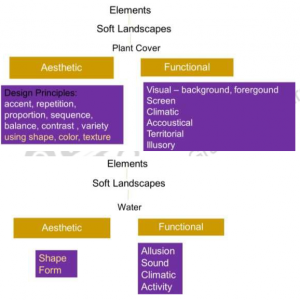
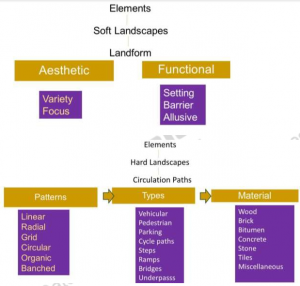
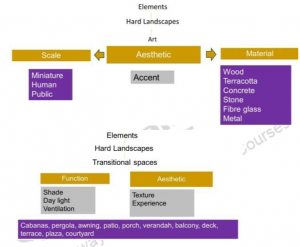
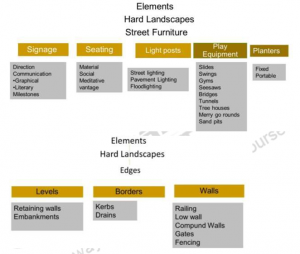
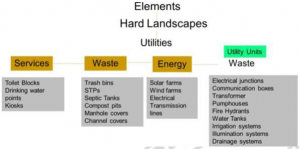
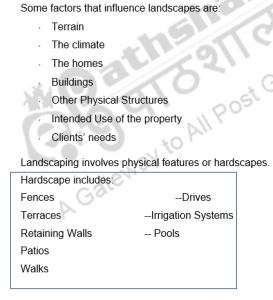
PRINCIPAL LANDSCAPE ELEMENTS
Plants – Trees, Shrubs, Ground Covers and Climbers.
Water – fountains, pools, cascades etc.
Landform – exposed rock elements, rock composition- sculpted slopes forming part of the interiors etc.
Architectural Elements – Paving, walls, pergola, trellis etc.
HISTORICAL REFERENCES
Water features like channels, fountains used in Islamic buildings.
Water used for symbolic and climatic purpose.
17th-18th Century French Interiors had potted orange / lemon trees, not for scent or
decoration, but to enable the guests to choose their own fruit.

SELECTION OF PLANT MATERIAL FOR LANDSCAPE
(I) Habit
(ii) Color
(iii) eason of flowering
(iv) Form
(v) Rate of growth and Environmental considerations.
FLOWER COLOUR
White: Alstoniascholaris, Baiiasea minor, Magnolia pterocarpaMilingtoniahorternsis and plumeriaacurmnaata.
Yellow: Cassia fistula, Bauhinia tomentosa, Saracaindica, Peltophorumpterocarpum and Tabebuiaspectabilis.
Red: Bombaxceiba, Amberstianobilis, Cassia marginata
Scarlet : Barningtoniamonandra, Cassia pavarnicaCrennigena,Kelnboviahospita.
Purple : Lagerstroemiaspeciosa, Bauhinia purpurea, Melia azadirach, Pachira, rosea and Tabebuiarosea.
Orange, Red, Crimson, Scarlet: Butea monosperma, Colviaracemosa and spathpdeacampanulata.
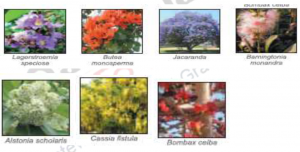
SEASON OF BLOOMING:
Ever blooming : Callisetermonlanceolatus, Mimusopselengi, Plumeniaacuminata and Thespesiapopulnea.
Winter blooming : Bauhinia purpurea, Butea monrosperama. Monodora grandiflora
Spring blooming : Tabebuia, Amheristianiobilis, Bombaxceiba, Jacaranda, Saracaindica, Spathodea
Summer Blooming : Erithrinaindica, Cassia, Jacaranda, Lagerstroemia spp.
Rainy season Blooming : Plumeria alba, Anthocepheluscadamba, Barringtoniaraccemosa, CasiaMarginata, P. rubra, Covillearaccemosa.

RANGE OF TREE SIZES
Dwarf trees (3 to 5m tall) :Albizialebbek, Bisantha, Bixcaorellana, Browneragrande eps, Crodiasebestena. WevthrniablackeinParkinsoniaacuminata, Plumeriarubra.
Medium size (6 to 10m tall) :Caesalpinia, Lagerstromiathroreli, Melia azadirach, Plumeriaaccmnata, SaracaInidica, Tabeuliaspectabilis.
Central Public Works Department 17
Handbook of Landscape
Tall tress (more than 110 m tall) :Peltophorumroxburghii, Bombaxmalabaricum, Cassia monisia, Chorisiaspeciosa, Jacaranda, Millingtoniahortensis, and spatholeacampanulata. Giant trees :Ficusbengalensis, Bombaxceiba, Colvillearacemose

GROWTH HABIT OF TREES
Oval : These plants are suitable for frame or screen.
Populusalba, Albizziajulibrissin, CrataeqscerusoalliCornus sp., Betula pendula Cassiafistula
Vase shaped : They can be used above the large shrubs or smalltrees.
Melia azadirach, Plumeriaacutifolia. P.alba. P.obtusa, SaracaIndica.Almus Americana.
Pyramidal : It can be used as an accent plant.Pinusroxburghii, Araucaria cooki. Thuja compacta, Quercuspalustris, Sterculafoedtida, Polyalthialongifolia.
Round : These plants can be used in the lawn as specimen.Plumeriaalba,ChorisiaspeciosaMimusopselengi. Morusrubra,Quercus.
Columnar : They frame the views and structure in the landscape setting. Juniperuschinensis, Betula pendula, QuercusrobustajEucalyptusrobusta, polyelthia pendula.
Weeping : It can be used as a focal point.Salix Babylonica, S. alba. Putranjivaroxburghii, callistemonlanceolatusTecomelia.
Round to spreading : These plants mass well to create groveeffect. Dalbergiasisso, DilleniaIndica, Ficusglomerata, Thespesiapopulnea.
Fan shaped : They can be used as a focal point.
Cycusrevoluta, Borassusfladellifer, Oredoxaregia..

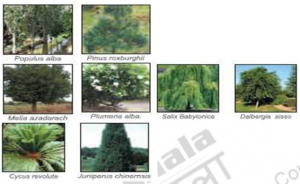
TREES WITH SCENTED FLOWERS
Trees with scented flowers : Anthocephiluscadamba, Alstoniascholaris, CananqiumodoratumMicheliachampaca, Mimusopselengi, Dilleniaindica, Gardenia latifolia, Custraviaaugusta, Magnolia grandiflora, Nyctanthesarbortristis.
VARIOUS TYPES OF RESISTANT TREES:
Wind Resistant trees : Eugenia jambolana, Caesalpiniapulcharima, Peltophorumpterocarpum.
Salt Resistant trees : AzadirachtaIndica, Acacia sp., Buteamonosperma, Azadirachta. Indica, BassiaLatifolia, Eucalyptuscitriodora, Phonixdactylofera and Phyllanthusemblica.
Drought Resistant : Butea monosperm, Acacia sp., Albizzialebbek. Casuariaequisetifolia. Crataevareligiosa. Tecomelia.
Wet Land trees : Nyctanthesarbortristis, DilleniaIndica, Michelia – champaca, SaracaIndica, Thespesiapopulnea, SalyxBabylonica, Ecualyptuseostata, Guaicum officinalis.
Fast Growing Trees : Pongamiaglabra, Sesbania grandiflora,Cananqiumodoratum, ErithrinaIndica, Thespesiapopulnnea,Populus sp., Salix sp,. Euclyptus sp., Thuja compacta.
Shade givers : Pteropsperumacerifolium, Albizzialebbek,Pelptophorum, Micheliachampaca, Anthocephaluscadamba, Dalbergiasisso,. GlyricidiaMaculataaccer sp., Cornusflorida.
Trees tolerant to Dust andSmoke : Acacia auriculiformis,Alstoniasoholaris, Butea monosperma, FicusBenjamina, F.benghalensis, MadhucaIndica, Pongamiaglabra, Ficusreligiosa, Terminalia Arjuna, Albizziallebbek, Bombaxceiba.
Trees for Noise Reduction : Terminalia Arjuna, Alstoniascholaris, AzadirachtaIndica, Butea Monosperma, MangiferIndica, MadhucaIndica, Juniperuschinesis, EucalyptusCitradora, Kigeliapinnata
Areca palm is a plant which removes CO2 and converts it into oxygen. We need four shoulderhigh plants per person, and in terms of plant care, we need to wipe the leaves every day. Mother-in-law’s Tongue is again a common plant.We call it a bedroom plant, because itconverts CO2 into oxygen at night. One requires about 6-8 such waist high plants per person inthe bedroom.Money plant is a very common plant; preferably grows in hyrdoponics. It is excellent plantfor removing Formaldehyde and other VOC’s (volatile chemicals) in the air.
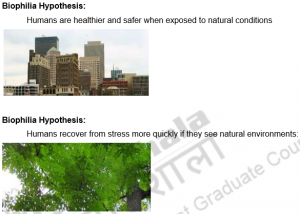
People want landscape elements in the Exteriors interiors.Wilson’s Bio-philia Hypothesis (1984) considers the judgment for landscape preferences to be based on the general affinity of human beings towards nature. This proposition though is in context to landscape preference studies, can be extended and interpreted in the current discussion. An urban dweller lacks contact with nature and within the introvert conditioned interior spaces the craves for greenery. Thus people want landscape elements inside the buildings. It is manifested as atrium landscapes, balcony gardens, bay window gardens, and many more.
| you can view video on Elements in Urban Landscape Part 2 |
